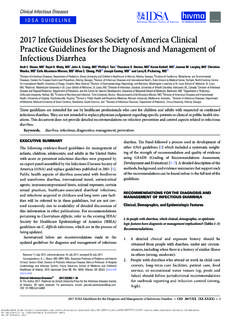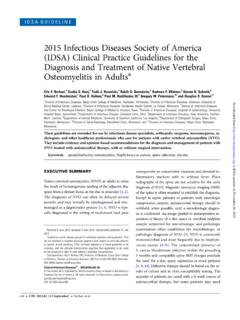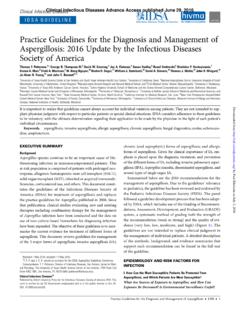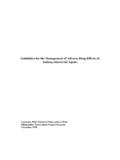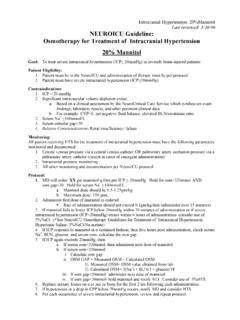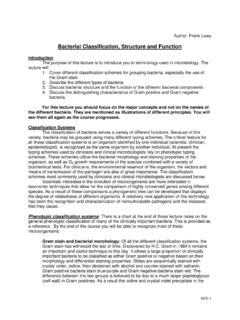Transcription of Clinical Practice Guidelines for the Diagnosis and ...
1 IDSA Guidelines . Clinical Practice Guidelines for the Diagnosis and Management of Intravascular Catheter-Related Infection: 2009 Update by the Infectious Diseases Society of America Leonard A. Mermel,1 Michael Allon,2 Emilio Bouza,9 Donald E. Craven,3 Patricia Flynn,4 Naomi P. O'Grady,5. Issam I. Raad,6 Bart J. A. Rijnders,10 Robert J. Sherertz,7 and David K. Warren8. 1. Division of Infectious Diseases, Warren Alpert Medical School of Brown University, Providence, Rhode Island; 2 University of Alabama-Birmingham Hospital, Birmingham, Alabama; 3 Tufts University School of Medicine, Lahey Clinic Medical Center, Burlington, Massachusetts; 4St. Jude Children's Research Hospital, Children's Infection Defense Center, Memphis, Tennessee; 5 National Institutes of Health, Critical Care Medicine Department, Bethesda, Maryland; 6 Section of Infectious Diseases, University of Texas-Cancer Center, Houston; 7 Section of Infectious Diseases, Wake Forest University School of Medicine, Winston-Salem, North Carolina; 8 Division of Infectious Diseases, Washington University School of Medicine, St Louis, Missouri; 9 Servicio de Microbiolog a Cli nica y E.
2 Infecciosas Hospital General Gregorio Maran o n, Madrid, Spain;. and 10 Internal Medicine and Infectious Diseases, Erasmus University Medical Center, Rotterdam, the Netherlands These updated Guidelines replace the previous management Guidelines published in 2001. The Guidelines are intended for use by health care providers who care for patients who either have these infections or may be at risk for them. EXECUTIVE SUMMARY tip should be cultured, rather than the subcutaneous segment (B-III). Diagnosis : Intravenous Catheter Cultures 4. For cultures of an anti-infective catheter tip, use General specific inhibitors in the culture media (A-II). 5. Growth of 115 colony-forming units (cfu) from a 5-cm segment of the catheter tip by semiquantitative 1.
3 Catheter cultures should be performed when a (roll-plate) culture or growth of 1102 cfu from a cath- catheter is removed for suspected catheter-related eter by quantitative (sonication) broth culture reflects bloodstream infection (CRBSI); catheter cultures catheter colonization (A-I). should not be obtained routinely (A-II). 6. When catheter infection is suspected and there is 2. Qualitative broth culture of catheter tips is not a catheter exit site exudate, swab the drainage to collect recommended (A-II). specimens for culture and Gram staining (B-III). 3. For central venous catheters (CVCs), the catheter Short-term catheters, including arterial catheters. Received 16 March 2009; accepted 18 March 2009; electronically published 2 7.
4 For short-term catheter tip cultures, the roll plate June 2009. It is important to realize that Guidelines cannot always account for individual technique is recommended for routine Clinical micro- variation among patients. They are not intended to supplant physician judgment biological analysis (A-II). with respect to particular patients or special Clinical situations. The IDSA considers adherence to these Guidelines to be voluntary, with the ultimate determination 8. For suspected pulmonary artery catheter infec- regarding their application to be made by the physician in the light of each patient's tion, culture the introducer tip (A-II). individual circumstances. Reprints or corresponence: Dr. Leonard Mermel, Div.
5 Of Infectious Diseases, Long-term catheters Rhode Island Hospital, 593 Eddy St., Providence, RI 02903 Clinical Infectious Diseases 2009; 49:1 45. 2009 by the Infectious Diseases Society of America. All rights reserved. 1058-4838/2009/4901-0001$ 9. Semiquantitative growth of !15 cfu/plate of the DOI: same microbe from both the insertion site culture and IDSA Guidelines for Intravascular Catheter-Related Infection CID 2009:49 (1 July) 1. the catheter hub culture strongly suggests that the catheter is alcoholic chlorhexidine ( ), allowing adequate drying time not the source of a bloodstream infection (A-II). to mitigate blood culture contamination (A-I). 10. If a venous access subcutaneous port is removed for 15.
6 For suspected CRBSI, paired blood samples, drawn from suspected CRBSI, send the port to the microbiology laboratory the catheter and a peripheral vein, should be cultured before for qualitative culture of the port reservoir contents, in addition initiation of antimicrobial therapy, and the bottles should be to the catheter tip (B-II). appropriately marked to reflect the site from which the samples were obtained (A-II). 16. If a blood sample cannot be drawn from a peripheral Diagnosis : Blood Cultures vein, it is recommended that 2 blood samples should be drawn through different catheter lumens (B-III). It is unclear whether blood cultures should be drawn through all catheter 11. Obtain samples for blood culture prior to the initiation lumens in such circumstances (C-III).
7 Of antibiotic therapy (figure 1) (A-I). 12. Where available, a phlebotomy team should draw the 17. A definitive Diagnosis of CRBSI requires that the same blood samples (A-II). organism grow from at least 1 percutaneous blood culture and 13. Skin preparation for obtaining percutaneously drawn from a culture of the catheter tip (A-I), or that 2 blood samples blood samples should be performed carefully, with use of ei- be drawn (one from a catheter hub and the other from a ther alcohol or tincture of iodine or alcoholic chlorhexidine peripheral vein) that, when cultured, meet CRBSI criteria for ( ), rather than povidone-iodine; allow adequate skin con- quantitative blood cultures or differential time to positivity tact and drying times to mitigate blood culture contamination (DTP) (A-II).
8 Alternatively, 2 quantitative blood cultures of (A-I). samples obtained through 2 catheter lumens in which the col- 14. If a blood sample is obtained through a catheter, clean ony count for the blood sample drawn through one lumen is the catheter hub with either alcohol or tincture of iodine or at least 3-fold greater than the colony count for the blood Figure 1. Methods for the Diagnosis of acute fever for a patient suspected of having short-term central venous catheter infection or arterial catheter infection. CFU, colony-forming units. 2 CID 2009:49 (1 July) Mermel et al. sample obtained from the second lumen should be considered bone marrow or solid-organ transplant, femoral catheteriza- to indicate possible CRBSI (B-II).
9 In this circumstance, the tion, or colonization due to Candida species at multiple sites interpretation of blood cultures that meet the DTP criteria is (B-II). an unresolved issue (C-III). 29. For empirical treatment of suspected catheter-related 18. For quantitative blood cultures, a colony count of mi- candidemia, use an echinocandin or, in selected patients, flu- crobes grown from blood obtained through the catheter hub conazole (A-II). Fluconazole can be used for patients without that is at least 3-fold greater than the colony count from blood azole exposure in the previous 3 months and in health care obtained from a peripheral vein best defines CRBSI (A-II). settings where the risk of Candida krusei or Candida glabrata 19.
10 For DTP, growth of microbes from a blood sample drawn infection is very low (A-III). from a catheter hub at least 2 h before microbial growth is 30. Antibiotic lock therapy should be used for catheter sal- detected in a blood sample obtained from a peripheral vein vage (B-II); however, if antibiotic lock therapy cannot be used best defines CRBSI (A-II). in this situation, systemic antibiotics should be administered 20. Quantitative blood cultures and/or DTP should be per- through the colonized catheter (C-III). formed before initiating antimicrobial therapy and with the 31. Four to 6 weeks of antibiotic therapy should be admin- same volume of blood per bottle (A-II). istered to patients with persistent fungemia or bacteremia after 21.
